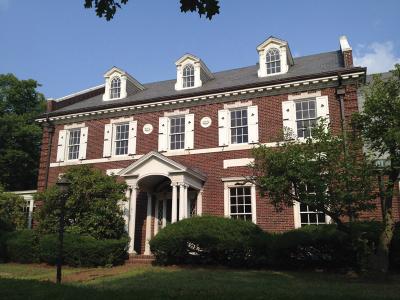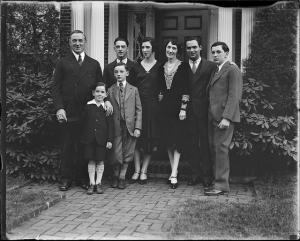March 2, 2015
On St. Patrick’s Day of 1915, a monument began to take shape in Jamaica Plain
 The city of Boston owns the “house that James Michael Curley” built on the Jamaicaway in Jamaica Plain. Construction on the Curley mansion began on St. Patrick’s Day, 1915. Image courtesy Jamaica Plain Gazette/Rebeca Oliviera
The city of Boston owns the “house that James Michael Curley” built on the Jamaicaway in Jamaica Plain. Construction on the Curley mansion began on St. Patrick’s Day, 1915. Image courtesy Jamaica Plain Gazette/Rebeca Oliviera
You’d be hard-pressed to find a more fitting but controversial symbol of Boston Irish success this or any St. Patrick’s Day. As a recent drive past the site affirmed, it still stands in Jamaica Plain – exactly one century since the grand structure first began to take shape on St. Patrick’s Day of 1915. Fittingly so, as the house’s owner was no less than “Himself,” James Michael Curley. In this scribe’s view, the house merits a look, so to speak, as the Boston Irish High Holy Holiday of 2015 looms a few weeks hence.
One hundred years ago, Mayor James Michael Curley decided to build a new house for his family. The home, however, was not just any dwelling. Rising on a verdant two-acre tract that offered a panoramic view of Frederick Law Olmsted’s “green necklace” along the Jamaicaway, Curley’s mansion soon evoked collective questions among his political enemies, the press, and even some of his supporters.
Bostonians from the wards and Brahmin residences alike wondered: How and where was the city’s controversial mayor raising the sums for the choice parcel of land and the manse gracing it?
Naturally, construction on “the house that James Michael Curley built” commenced on St. Patrick’s Day 1915. In virtually every way, the mayor’s new neighborhood stood as a polar political and cultural opposite to his home turf, Ward 17 in lower Roxbury. Curley’s property, pastoral in setting, was flanked by stands of trees and by topiary gems similar to the shrubbery that many of the wards’ Irishmen had long pruned for Brahmins, but that few had ever owned themselves. In nearby Brookline, site of old Yankee estates and the rarefied golf course and bridle paths of The Country Club, lived the genteel set who viewed Curley as little more than a usurper.
From the moment that work crews begin setting the mansion’s foundation, questions continued to swirl about Curley. He had commissioned the renowned architect Joseph McGuinness to design a neo-Georgian estate similar to those Anglo-Irish structures that dotted Ireland, the mansion stretching and soaring over ten thousand square feet and featuring some twenty rooms. A tiled roof crowned the mayor’s new home, which was adorned with a heated garage and surrounded by brick walkways. The landscaping was worthy of a country squire’s estate.
 The Curley family outside of their home on the Jamaicaway in 1930. Photo by Leslie Jones/BPL Collection
The Curley family outside of their home on the Jamaicaway in 1930. Photo by Leslie Jones/BPL Collection
As magnificent as the home’s exterior was, visitors gaped at the trappings within the mansion’s walls. A costly crystal chandelier illuminated the long dining room, where burnished mahogany-paneled walls reflected not only the chandelier’s light and shadows, but also an aura of the owner’s power. The nearby first-floor hall sprawled sixty feet, and in virtually any direction that guests moved either downstairs or upstairs, they ran into carved mahogany doors, twenty-eight in number.
With five children, the mayor and his wife, Mae Herlihy Curley, had ordered McGuinness to incorporate five bathrooms in the home. They reveled in their home’s high ceilings, sat in front of fireplaces where flames cast their glow across imported Italian marble, and reached for fixtures plated with gold. Perhaps the grandest touches of the wards’ poor-boy-made-good were the front hall’s bronze chandelier – two stories high and once having graced the Austro-Hungarian embassy in Washington, D.C. – and the spiral staircase that wound up three stories.
What, many of his “old crowd” wondered, had happened to the man who had come from, and spoken for, the people of the old neighborhoods against the entrenched interests of Yankeedom? Curley, with typical aplomb, probably thought that he answered such questions with the carved shamrocks that emblazoned the mansion’s thirty white shutters. The emblems were hardly enough to quiet his Boston Irish critics – especially foes already screeching the words “graft” and “corruption.”
In the rough-and-tumble ranks of Boston Irish politics, Curley was ever battling battled enemies sporting similar bloodlines from the “old sod” but assailing him with a venom equal to that of his legion of Yankee detractors. Curley would recall how John F. Fitzgerald, who also had won the mayor’s office, “joined my critics” over the Jamaicaway mansion. “A few years ago,” chided Fitzgerald, “James M. Curley was working as a corporation inspector for $3 a day. The year before he was elected mayor he paid nothing except a poll tax. Now he has a beautiful home on the Jamaicaway, with furnishings from the home of Henry H. Rogers [a Standard Oil baron], who died worth $100,000,000. He recently disposed of a fine summer residence at Hull, bought since he became mayor.”
Curley, contending that Fitzgerald was the proverbial “pot calling the kettle black,” retorted: “I might remark parenthetically that when John F. retired, he spent most of his time on his estate in Hull, and he owned another fine house in Concord. It did not occur to him, apparently, that I disposed of one residence so I could purchase another.”
That Curley was drawing from a murky source or sources of funds was evident, writes Jack Beatty, in his definitive Curley biography, “The Rascal King.” Beatty notes that in the 1950s, nearly four decades after the controversy over the Jamaicaway mansion had erupted, John Henry Cutler, who ghostwrote the mayor’s memoir, “I’d Do It Again,” asked Curley, “Governor, did you pay for that house?” Cutler would recall: “He gave me a wink as if to say of course he didn’t pay.”
Today, after 100 St. Patrick’s Days, the Curley mansion still stands, “the house with the shamrock shutters.”

